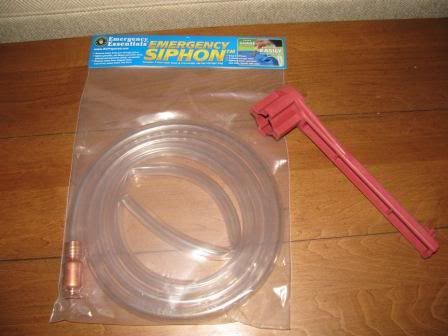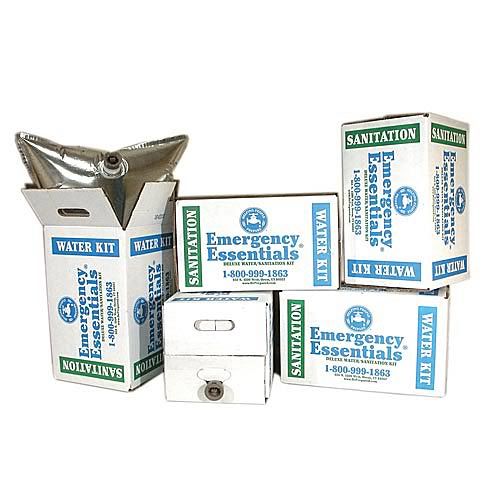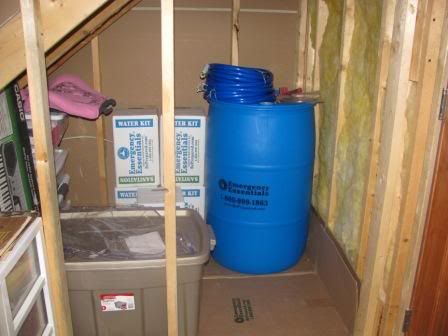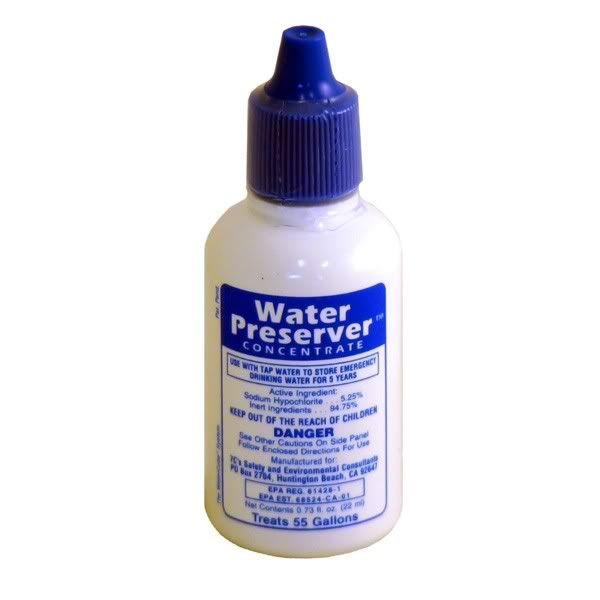Water is one of the most important items in preparedness. You can't survive very long without water and yet it is something that we all take for granted. We just expect that clean, safe water will always flow out of our faucets. That is something that you absolutely cannot count on in an emergency. Municipal water supplies could be contaminated or they could be out of order. If you are on well water, a loss of electricity would cut power to your pump. A major local, regional or national power grid outage would then leave you up a creek without a paddle. Bottled water is one of the first items to get sold out in anticipation of a hurricane, snow or ice storm. Be ready ahead of time!
6 people x 1 gallon per day x 14 days = 84 gallons

It is important that your water storage containers be made of food-grade materials. You should never store water in something that once held anything you would not put in your body (gas, cleaners, etc.). I chose to buy our water storage containers but you can use clean and empty pop or juice bottles. Some people are able to get barrels that held syrup, etc. for free from restaurants. Be sure to clean your containers thoroughly if you go that route and again, make sure the containers are of food-grade plastic.

 The kit consists of heavy duty mylar bags that have a spout. You fill the bags with water and place each one in a cardboard box. The boxes have handles and stack easily. The kit is reuseable and seems like it would be pretty sturdy as long as your basement or other storage area stays dry.
The kit consists of heavy duty mylar bags that have a spout. You fill the bags with water and place each one in a cardboard box. The boxes have handles and stack easily. The kit is reuseable and seems like it would be pretty sturdy as long as your basement or other storage area stays dry.This is what my storage area looked like with my storage containers filled up and ready to go.

I went ahead and placed some cardboard underneath the water barrel. Many people recommend that you have some sort of separation between your plastic water containers and the concrete floor. The thought is that chemicals from the concrete can leach through the plastic into your water. Other folks think that as long as your concrete is not getting heated up (ie. from the sun, outdoors, etc.) you are fine. I chose to put a layer of cardboard underneath my water barrel even though our concrete stays cool all year long. Another solution to this problem is to rest your barrel on top of some 2 x4s.
If you're adding it up, this totals 80 gallons of water and my family needs 84. We do have an additional three days' worth of water stored in our BOBs in the form of Aqua Blox. Should we need even more water, we have two 40 gallon water heaters. You can also use the water in the tank of your toilet (not the bowl!). In all, we have enough water for nearly four weeks.
In the future I plan on buying a large Berkey water filter for more long term solutions. While we do not have a natural source of water on our property, we do live in an area where there are many farm ponds nearby. If TSHTF, we could haul in water from those ponds or a nearby public lake and then filter it. We also have some water treatment tablets and bleach that could be used to disinfect suspect water if necessary. Boiling water once you filter out the big particles is always an option as well.
Do you need to treat your water?
Generally speaking, if you are filling your water containers with water from municipal supplies, you do not need to add any sort of water treatment. You do, however, have to rotate your water, dumping it out and refilling your containers every 6 months to 1 year.
If you add this water preserver sold by The Ready Store, however, you can extend the time water stays fresh in your containers to 5 years.  I don't know about you but I don't have the time or inclination to dump out 84 gallons of water every year, so this was a good investment for me.
I don't know about you but I don't have the time or inclination to dump out 84 gallons of water every year, so this was a good investment for me.
Another thing you should think about is how you are going to fill your water containers. Most garden hoses are not considered safe for drinking water. They can have lead and other chemicals leach out of them or even harbor mold and mildew. I went ahead and bought a couple of water-safe, mold resistant hoses.  You can find these online at emergency preparedness stores or even at your local Wal-Mart in the RV or garden section. In the end, filling our water containers from our regular garden hose probably wouldn't be a big deal, but better safe than sorry in my book. After all, that's why I'm a prepper.
You can find these online at emergency preparedness stores or even at your local Wal-Mart in the RV or garden section. In the end, filling our water containers from our regular garden hose probably wouldn't be a big deal, but better safe than sorry in my book. After all, that's why I'm a prepper.
NUCLEAR PREPAREDNESS













No comments:
Post a Comment